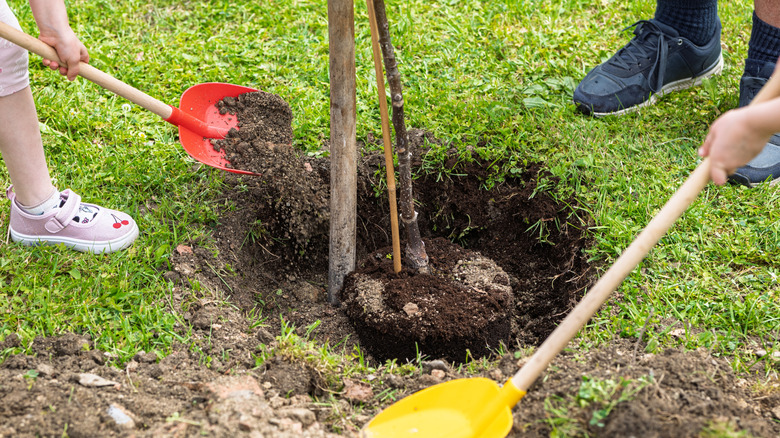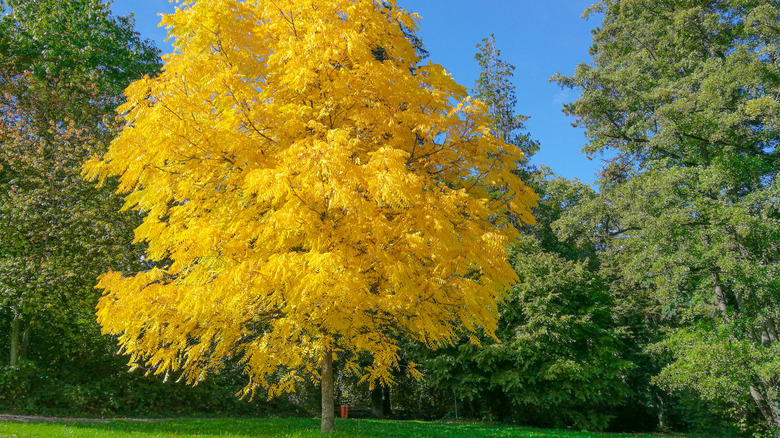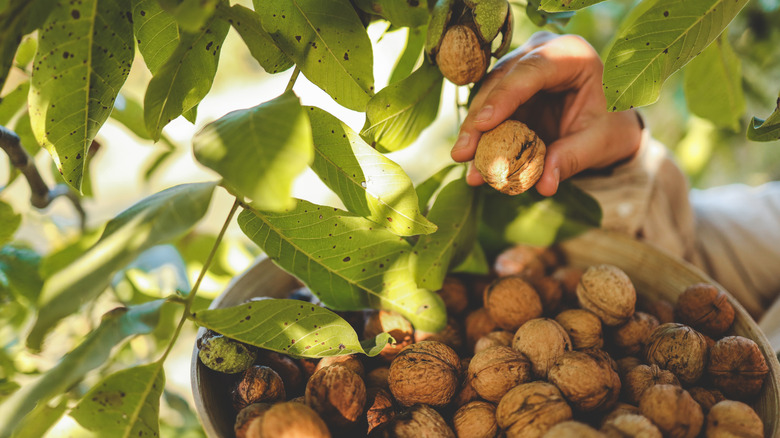What You Should Know Before Trying To Grow A Walnut Tree
Planting the right type of tree can possibly make your home look more attractive and is among the key landscaping tips to affordably boost your property value over time. You might also reap other key benefits, such as shade, foliage color changes, and fruit. A walnut (Juglans) tree is one possibility that can check off all these boxes. But before you commit to growing this attractive tree, know that you need to choose the right cultivar based on where you live, have a lot of space on your property, and follow the right care techniques to ensure your walnut tree stays healthy for many years to come.
First, it's important to know about the main cultivars. While there are technically 20 different types of walnut trees, the two most common varieties grown in the U.S. include black walnut (Juglans nigra) and English walnut (Juglans regia). Black walnut is native to central and eastern parts of North America, and it's arguably the most common type grown on residential properties, with cultivars including 'Sparrow' and 'Thomas.' English walnut varieties, such as 'Chandler,' 'Hartley,' and 'Franquette', are commonly grown across both North and South America. Nevertheless, these are still sometimes grown around homes, too. If you live in a warmer region, experts recommend that you consider 'Chandler' or 'Hartley' cultivars. Areas that tend to have more frost and colder winters may do better with 'Thomas' or hybrid walnut cultivars. On the flipside, if you live in an area where you may sometimes get frost later in spring, stick with 'Chandler' and 'Franquette' varieties. If you're uncertain, you may consider speaking with a local nursery or arborist.
Space is a key consideration before planting a walnut tree
Once you have the correct walnut tree cultivar narrowed down for your region, now's the time to determine whether you have space for it. These large trees need a lot of space for their deep roots, so you will need to plant them far away from your home, driveway, sidewalk, septic tanks, and any other area that can incur damage as the trees grow.
In general, black walnut needs about 50 to 75 feet of root space in the ground. Once planted, they can grow about 2 feet per year, eventually maxing out at 50 to 90 feet tall. 'Sparrow' varieties of black walnut trees tend to run a bit smaller, but these are still large plants that need a lot of space. English walnut, on the other hand, can grow between 40 and 60 feet tall, and it needs the same amount of growing space. If you've determined your yard cannot adequately accommodate a walnut tree, you might consider one of the 15 small trees that won't overtake your yard instead.
If you've mapped out the area for your walnut tree and have ensured it will have enough space, you can then start the planting process. As a good rule of thumb, you'll want to dig a hole that is twice the length of the current root system, but just deep enough for it to reach the root collar itself. Fill the hole with a 1/3 ratio of organic matter and soil, and add mulch on top.
Other steps for successful walnut tree growth
In general, walnut needs full sun and either well-draining or wet soil. They do not care for excess shade or overly dry conditions. You can grow them in areas with clay and loamy soils, too. Overall, black walnut does best in USDA hardiness zones 4 to 9, while English walnut can grow in zones 3 to 7. As the tree becomes established, consider pruning it every late summer or fall for better growth in the spring.
While you may be able to start harvesting the black walnuts within 8 to 10 years, the best production doesn't begin until the tree is at least 30. English walnut needs a bit less time, though ideal production doesn't start until the tree is between 15 and 20 years old. Another key factor in nut production is that the tree will need another cultivar nearby for cross-pollination purposes.
Just as there are mistakes to avoid while watering your garden, you will want to make sure your walnut tree gets the right amount of water without getting too much. Walnut trees need the most water within the first couple of years, but overwatering them can damage them. Consider watering only when the soil is dry. After this time, the tree may only require deep watering once a month, with more sessions needed during the hot summer months. Finally, it's important to be on the lookout for common diseases in your walnut tree. The most prominent is thousand cankers disease, which is particularly fatal in black walnut trees after 2 to 4 years.


